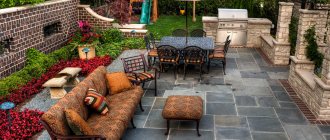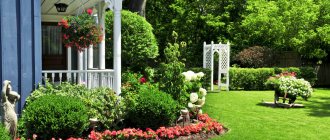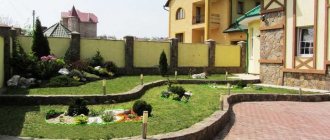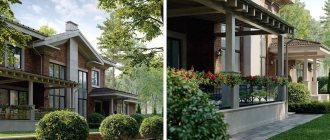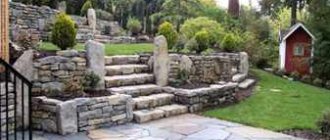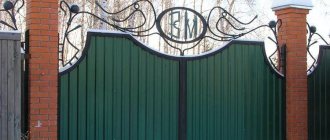Home » Yard and garden
Yard and GardenHouseLandscape Design
Novozhenina Anna
170596 Views 3 comments
A well-kept yard allows you to frame your home favorably, provides self-presentation and the basis for further impressions. Well thought out and organized yard design and landscaping should complement the natural surroundings and continue the interior design intent. Everything will be discussed in more detail later in the article.
Backyard Makeup Ideas
After reviewing the basic rules of landscape design, move on to landscaping the space. Check out the ideas below for landscaping your backyard.
Replace obsolete materials
For this purpose, solid concrete with brick strips is now often used. Make a patio area with concrete, add white sand and add a fountain for dramatic effect.
Enlarge your patio area
A common backyard mistake is making the patio too small. When you're working on your backyard makeover, consider extending the patio to accommodate larger furniture and provide walking around the space.
Patio is a useful yard decoration
Re-paving
Plain gray concrete can be quite boring. Transform your backyard pavers to transform the feel of your entire area. When redoing paving slabs, you have two options: remove the existing sidewalk or transform what you have. Create stains and etchings on the concrete path to make it look like natural stone. If you want to remodel your existing paving, you'll save money on materials and labor.
Low cost garden paths
Don't let small or awkward spaces limit you
Tight spaces can be a challenge and often end up going unused. However, you can transform a narrow space into a backyard fully equipped for outdoor activities. Creative layout and space-saving techniques can be used to fit more features into a small or awkward backyard.
DIY your backyard
You can remodel your backyard yourself, without professionals and their resources, if the matter is limited to feasible work. However, this does not include demolition and installation of new small architectural forms, as this work will take the average homeowner weeks to complete, while a team of professionals can do it in a few days.
Lots of ideas for creating beauty
Projects that involve installing running water, gas, or electrical lines may be additionally complicated. If you want a fountain, a built-in grill, or lots of lighting, it's best to hire a licensed professional. However, when choosing a DIY option that will save you some money, consider planting your own plants. If Make sure you know the requirements for each plant to choose the best location. Consider also installing a patio area yourself.
Laying the paths
After we have divided the territory into zones, it is necessary to make sure that you can easily move between them. To do this, it is worth equipping special paths in the yard. They can be completely different: some will like winding paths, some will prefer straight trajectories, and some will like something in between.
The track material also provides a huge choice:
- large flat stones;
- brick;
- gravel;
- concrete plates;
- cobblestone.
Paths can be left without fencing or emphasized with a small fence or decorative border.
If the area is uneven, it can be designed in different planes, connecting adjacent segments using stairs.
See alsoCreating a flower garden is one of the forms of creative self-expression
Patio Design Ideas
Patios are all about outdoor living. You'll likely spend many hours with friends and family on your patio. Instead of purchasing a large home, many people are looking to expand their outdoor living space. The result is a larger, more luxurious and more secure patio area.
Outdoor patios have become hubs of activity, focused on entertainment and relaxation. A well-designed patio will not only add additional living space to your home, but will also increase its resale value.
Organization of a recreation area
Since your patio will provide the foundation for your outdoor living space, it should be durable, well-constructed. There are a variety of patio and paving materials to choose from. Determine what size, shape and style of patio best suits your needs. Use the information here to start collecting ideas for your new patio.
It's time to stop thinking of your patio as just a place to spend time outdoors. It can serve as a hub for a variety of functions including dining, cooking, socializing and relaxation. The style of your patio will change depending on what features you want to accommodate.
Site design
The design of a place begins with the idea that it will subsequently acquire the appropriate stages. An excessive accumulation of different figures, incompatible colors and statues of different configurations has long ceased to be widespread and tempting.
A unique design composition in combination with other spectacular and intricate configurations can lose its own irresistibility.
For this reason, before starting work, you should visualize your thoughts and create a project for the site on the drawing. It is also important not to be afraid to use bold conclusions and trust your intuition.
Concrete patios
The durability and versatility of concrete makes it an excellent choice for paving your patio. A concrete patio has many advantages compared to corrugated sheets and other surfaces.
Concrete patio in the courtyard interior
Benefits of concrete patios:
- Highly durable.
- Low operating costs.
- Adaptable to any style.
- Can be poured into any shape.
Decor options:
- Colored concrete. There are several ways to paint concrete, including contrasting, integrating, solid and liquid painting methods (used in combination with embossing), and full staining.
- Embossed Concrete – The surface of your concrete patio can be stamped to create a texture that mimics stone, brick or other materials.
Embossed colored concrete to look like stone
If you already have a patio that is cracked or dirty, you can clean it with concrete. Concrete sanding will make your patio look like new. A reclaimed concrete patio can be painted and stamped.
Another strong trend is to integrate plants into areas where expansion joints would otherwise be located. They help create a more breathable surface and break up the vast structure with greenery. It is not uncommon to use artificial turf in these areas, especially in areas where moisture needs to be maintained.
Grass between seams to maintain moisture
Are concrete patios susceptible to cracking?
Concrete is good for warm climate landscapes that do not experience the extreme freeze-thaw cycles of northern regions that cause uncontrolled cracking. Other factors can also lead to cracking.
This will be of interest to you: Do-it-yourself landscape design for the garden (185+ Photos). Styles You Should Know About
Colors
The design of the site should be carried out in style.
Monochromatic - The most common type of design is a monotone color resolution. To do this, it is possible to combine different colors of the same palette. With this design, it is easier to make the design of the site complete and not overloaded.
Two-tone - in this case, you should choose a single tone that blends flawlessly with emerald. The most suitable types: snow-white, lilac, chestnut, and lilac.
Also, having selected one of the colors, you can simply decorate the area with optimal colors, statues, benches and other components. I do not recommend combining greenish with blue and red.
Multicolor is the most famous type and may seem tempting and easy to use alone. However, here it is possible to make a large number of errors, to overdo it with diversity and colorfulness.
In order not to wrap the area in alternating colors, I recommend using no more than 5 different colors.
Ideas for gazebos
Gazebos and other shade structures are another way to enjoy nature even if the conditions outside are not the best. During the hot summer, you can relax and have fun outdoors without getting sunstroke. Shade structures also extend the season into fall and winter. If your structure is built with a solid roof or even insulated walls, you can enjoy calm winter mornings while sipping tea without the worry of rain or snow.
Cozy gazebo for summer relaxation
Types of shadow buildings
Gazebos are a self-contained structure, organically placed in the landscape. They can stand on a path and define a space for a walk, or they can define a patio area or outdoor entertaining space. A pergola usually has open sides and a slatted or solid roof.
Pergolas in landscape design
Patio structures are similar to pergolas, except they are attached to the house. This can be an advantage because the patio area can use the house for support and therefore can cost less than a freestanding structure.
Octagonal-shaped gazebos with a durable roof are most often used in traditional gardening areas. They can be an attractive addition if the style of the surrounding landscape works with the structure.
Traditional garden and park area
A canvas canopy is a modern way to get relief from the sun. The fabric is stretched through specially designed posts to accent and cover a seating area or patio. A canvas canopy looks great with the straight lines and simple geometries used in modern homes, and does double duty as a decorative and artistic part of the landscape.
Canopy for gazebo
A screened deck is built right next to the home, usually at the back door for easy access. Instead of glass windows, it has large screens to keep out insects. A screened terrace is great for dining as you get quality time outdoors without any uninvited guests.
A sun room is also being built right next to the house. Because it can be fully insulated and built with two-pane windows, it is a four-season structure that acts as an addition to your home. The sunroom is completely weatherproof, so you can watch birds and wildlife in comfort, even in winter. What really sets a sunroom apart from the rest of your home is that it has lots of windows that enhance outside views.
We create reservoirs
Just imagine how pleasant it is to enjoy the coolness of a clean pond in a shady corner of your own garden on a hot summer afternoon. Construction of a reservoir is a rather labor-intensive, but worthwhile process.
An artificial pond can be made in completely different variations.
- Small pond. Populate it with fish, decorate it with stones and water lilies, and this place will become of great interest to guests, and will also become a favorite place to play for the younger generation.
- Elegant fountain. This structure can take up very little space and is suitable for small yards. But its pleasant splashes will be a real salvation from the summer heat.
- A mischievous stream or a miniature waterfall. Their murmur relaxes and creates a unique atmosphere of relaxation alone with nature.
To make it pleasant to be in the yard, you need to keep it clean
Well-groomed flowers and trees will look great in your yard
You can plant flowers next to the path
See also: What can you use to make paths in your dacha cheaply and beautifully?
Terrace decoration
No matter what size backyard you have, you can make the most of the available space and live the dream. Here are some easy DIY landscaping ideas to create a great outdoor space that you can enjoy day and night.
Customize your space with decking
There's nothing like a new deck to transform your backyard into an outdoor living room or a great party spot. It's an easy, affordable way to expand your living space that will last for many years, and with a little know-how, you can build it yourself.
Terrace – a room with decking
There are several options for decking materials. In addition to traditional wood flooring, there is an eco-friendly alternative. Composite decking can be made from recycled plastic, which is durable, easy to install and maintain, and resistant to rot and pests.
Build with beams
Beams made from environmentally friendly material
You can shape your backyard to any size and give it a natural, earthy look with treated pine beams. Treated pine beams are resistant to decay, fungus and pests, making them one of the most versatile, easy-to-use and hard-wearing landscaping materials on the market. They can be used to create a retaining wall, stepped garden, flower bed or as a border along your beds.
Space with retaining walls
Retaining walls are a great way to create interesting steps for your backyard design. You can use them to create a raised garden to surround your entertaining space or create a quiet corner to unwind. Retaining walls are also a good way to level out areas of sloping block and add extra space for the kids to play or for you to entertain. Depending on the look you want, retaining walls can be made from logs or treated pine sleepers. Use specially formulated wall holding materials that are interlocking, durable and come in a range of colors.
Own paving
You can add real definition to your backyard and create a great look with pavers. Plus, it will be an easy project that you can do yourself. Pavers make a solid base for your outdoor entertaining area, or you can create a path through your garden. There are a variety of colors and installation designs on the market to suit any backyard, from concrete textured pavers, panel pavers, and sand pavers.
Simple and convenient covering for the yard
Add color and texture with pebbles
Pebbles are an easy way to bring different colors and textures to your backyard. You can use it to fill empty spaces in garden beds or as a ground cover to complement a paved or decked area.
For a purely decorative look, you can use pebbles to create a border or landscape path. There are many colors and styles to choose from in white, blue, orange, red, green, lime, silver or gold. Using the same colored pebbles, you can create solid colored areas or mix colors to create a brighter look.
Bright flowerbed using pebbles
Where to begin
A well-groomed, landscaped summer cottage is the dream of, perhaps, every owner of a house with adjacent land. There is a completely unfounded opinion that only a professional can bring shine.
To argue with or agree with this statement is a personal matter for everyone, but arranging a summer house with your own hands is a completely feasible task. The main thing is to cast aside fear and doubts, understand the material, decide on your desires, and then you can get down to business.
Perhaps in some ways the design of the site will be inferior to that made by professionals, but the fact that it will be original, with its own individuality, outweighs all possible shortcomings.
The design of a garden plot begins with drawing up a plan. You can use graph paper, a ruler and a simple pencil the old fashioned way, drawing in the selected scale all the elements that you plan to place on the site.
You can take advantage of modern technologies and draw up a plan in one of the computer programs specially designed for this. It is designed as a projection, top view, observing proportions in the sizes of parts and elements.
The plan should be as detailed as possible. It is necessary to take into account everything necessary for a dacha and garden: entrance, paths, trees, decor, vegetable garden, buildings and structures, the design of which is determined before the start of landscaping work.
During the process of implementation, the plan will partially change, some ideas that came to mind a little later may find embodiment, but will be discarded into the original ones. The main thing is to have something to start from at the start.
In cases where the design of a summer cottage is adjusted to existing realities, all buildings, paths, flower beds and other important elements must be placed on the plan, as accurately as possible, in order to accurately fit them into the new exterior.
It is important to consider the location of not only large structures, such as a gazebo, covered terrace, bathhouse, barn, but also to consider the location of an artificial pond or inflatable pool.
Plants play an important role. However, you need to take into account that:
- tall bushes and trees will create shade,
- climbing and curly ones require support,
- not all flowers can be adjacent to each other.
Flower beds, flower beds, rock gardens, and alpine slides are arranged taking into account the relief. Special attention is given to decorative elements: benches, garden figures, lanterns, fences.
Front yard landscaping
When it comes to decorating your front yard, you'll want to think about what features of your home will be highlighted, as well as how you can transform it into an outdoor space that gets lots of use. If you want to spend your holiday time there, privacy will be key. Privacy can be created with a wall or hedge.
Get a new perspective
Before choosing a project, look at your landscape with fresh eyes and a broader perspective. We are so accustomed to our landscape that it can be difficult to determine what others might see. There are two simple tricks to see the landscape from a new perspective. With both of these methods, the goal is to forget what you think about your landscape and instead look at what actually exists.
The first is an old artist's trick. Get far enough away from your landscape that you can see everything at once. Then squint your eyes until the picture blurs and try to clear your memory.
“Paint” your picture to create a landscape
There may be areas that, when viewed blurredly, appear dark and overgrown. Some areas may look messy because there are too many small plantings, statues or pots. Or, you may have an area that is bright and clean, but a little too empty. All these ideas can give you a general idea of which projects to tackle first.
The second technique you can use to see your landscape with new eyes is to take black and white photographs of your landscaping. By adding color, you can make a familiar space feel new, so you see it with objective eyes. Nowadays, most digital cameras have a black and white setting, so this is easy to do even if you are not a techno genius.
Define boundaries and add mulch
Clean edges deceive the eye, creating a neat and well-kept landscape. If the lawn has encroached into the garden beds and created an uneven line, defining a boundary can improve the appearance of the entire landscape.
Start by laying out a garden hose to define the new boundary. Don't make the beginner mistake of creating a wavy "drunk snake" line. Instead, make wide curves that are scaled to the size of your home. Then use a hoe to cut the grass until you have a clean, attractive line.
Define a beautiful mulch line
Once you've established a neat border, add a layer of wood chip mulch for a sophisticated look. The bright color is attractive, smoothes out uneven soil surfaces and generally gives landscaping a professional finish.
Trim huge bushes
If the plant is clearly not intended to be a hedge, then it needs to be pruned. Otherwise, it will feel like the service is out of control.
Prune the shrub at the base, removing any branches that are within 6 inches of the ground. This gives a more open look and works wonders on Rhododendrons and other shrubs that can appear gloomy and overwhelming when sprawled across the ground.
Neat bushes in the yard of the house
Another good task is to carefully trim any plant that touches the house. Plants that lean against your home can cause paint cracking, as well as mold and ants. Trimming plants 20 to 30cm from the house will give the landscaping a more open look and also give you the opportunity to clean the house or paint it if necessary.
Arrangement of the yard of a private house depending on the stylistic direction
Many people like to look at photos of beautiful courtyards of a private house, hoping to create a miracle with their own hands on their own plot. Well, it's absolutely real. If you don’t try to arrange the territory in the same style, you will end up with something motley, devoid of a single concept. Such a yard would not be called special. When there is a desire to create something aesthetic, cultured, beautiful, they do not act on the principle “I made it from what was.”
The issue of choosing a style is the second most important point after zoning. All materials and decorative elements must be selected in accordance with the chosen garden style. Among the styles in which you can arrange your yard are Mediterranean, English and Japanese. They are not found all the time and amaze with their novelty, originality and culture.
Mediterranean style
How to decorate the yard of a private house in a Mediterranean style? For northern yards this is quite problematic due to the characteristics of the local flora. In general, the style reflects the shores of the southern seas: an abundance of processed and unprocessed stone, rounded pebbles, terraces, ladders, shading from the sun. In northern gardens there is no need to shade the garden at all, but terracing allows you to grow more heat-loving plants in the summer.
Pebble paths won't appeal to those who like to walk into the house in heels, but for the rest of us it will be a real pleasure
Who said openings have to be rectangular? The entrance to an ordinary barn can be designed in the form of an arch, which will be an excellent design element
Not everyone wants to see a yard covered with a carpet of flowers. For such people there is a solution in the form of a paved terrace. The decoration will be columns and sculptures. Such architectural forms require virtually no maintenance.
Huge flowerpots will always find a worthy place in a Mediterranean patio
The abundance of stone eliminates excess vegetation, but people whose garden is located in the steppe zone should take into account that the stone heats up well, and not every plant will be happy about this, because the climate is by no means marine!
English style
If you want to improve the yard in a private house, as in the photos showing decorous English gardens, then you should immediately understand that it will not be possible to create the ideal option everywhere. Many plants in an English garden will feel better in the harsh conditions of Siberia than in the hot steppe lands. But if you want, you can create an oasis in the desert, right?
The English style is characterized by naturalness in everything except the neatly trimmed lawn. The lush greenery here is divided by winding paths, the flower beds have an irregular shape, the trees look untrimmed, but in fact, each leaf is in its place by the will of the gardener.
The gazebo should not be visible from each end of the site: the place and plants are selected in such a way that the resting place appears before the eyes by chance, and all thanks to the winding path winding through the garden
There is usually a terrace in front of the house or next to it
The reservoir must be natural - if a ready-made plastic form is used, it should in no case be visible: the edges must be decorated with sandstone, pebbles and plants
Spacious yard allows you to use large spaces for a neat lawn
Buildings must be entwined with ivy, wisteria, virgin grapes, clematis - any vine
All sculptures and stone elements must be harmoniously integrated into the English style
Japanese style
The refined taste of the Japanese, their special sense of beauty and ability to find beauty in those things that other people will pass by - everything is reflected in the Japanese style in the garden.
There are no wildly blooming flower beds here, only contemplation and peace
The reservoir should look as natural as possible, as if it had been here since the cradle of civilization
The decoration of the garden will be mosses, original shaped driftwood, stones
The emphasis is on the special shape of the crown of low trees
Not everyone has the patience to shape a tree: it takes more than one year
Sedateness and calmness
If the main characteristics of the owner of the house are patience, hard work, and the ability to contemplate, then such a garden will become the embodiment of the mystery of the soul for a person.
Trees
The key quality when choosing a tree for your front yard should be its discreet appeal. The right tree can transform a front yard, adding structural interest, seasonal color, shade and dimension. The best tree choice for your front yard depends on factors including your climate, the space you have, preferences, and the orientation of your landscape.
Trees for small spaces
When choosing a tree for a small front yard, look for a specimen that will create a focal point without dominating your home or landscape. There are many small or dwarf tree varieties that will not grow taller than 8 meters, but have eye-catching features that more than make up for their lack of height, such as interesting leaf shapes and unique branch directions. Good options include dogwoods, Japanese maples, cherry trees and purple plum trees.
Decorative trees for small spaces
Blooming
Flowering trees will give your front yard a welcome splash of color after a long winter, often before the rest of the landscape comes to life. The effect will be similar to the shape of a vase full of flowers, providing a temporary but vibrant splash of color and an intoxicating aroma. Many flowering trees also provide multi-season interest, producing colorful berries and vibrant fall foliage such as flowering cherry trees, myrtle, apple trees and eastern redbells.
Shadow
Planting trees for shade in front of your home can block the harsh morning and afternoon sun from pouring into your windows, keeping your home cooler throughout the summer. Their dense canopies of leaves also slow the evaporation of water from lawns and garden beds. Shade trees come in many shapes and sizes, but fast-growing varieties deliver their benefits sooner. Examples include red maple, oak, poplar, birch, and ash.
Slender birch tree on the site near the house
For autumn foliage
Every front yard should have at least one tree that provides dazzling fall color, with leaves that turn seemingly overnight into brilliant shades of yellow, orange, red or purple. Some trees, such as the sugar maple, will produce a kaleidoscope of colors, ranging from yellow to orange and finally to red.
Evergreens
While many deciduous trees will reward you with spring flowers and fall color, their glory often fades in the winter after the leaves have fallen, leaving you with a lifeless landscape. Almost any front yard can benefit from the year-round color and sculptural beauty of conifers.
Landscaping of the site
This procedure is considered the basis of plant design. All plantings, without exception, must be combined with each other. Grass is considered an integral part of each site. This is not a decorative component, since the plant absorbs excess water and dust, in return it gives freshness and neatness.
The grass is selected by pushing away from the direction of the clearing. If you preserve ordinary, unrefined vegetation, the area will look careless and disharmonious. It is possible to use different types of lawn in different places on the site.
If you need undemanding grass that does not require frequent mowing, then it is more correct to select the composition of bentgrass. For the purpose of walking animals, I recommend choosing the most strict and strong grass - sports grass.
A lawn is suitable for landscaping the area of the site. If you are a beginner in aerial landscape design, then it is better to use a multifunctional view.
He is less strict in courtship, but also maintains an attractive and neat type for a long time. It is possible to use finished narrow-rolled lawns - they will quickly make the area more comfortable.
Lawn care
- First you need to get rid of the weeds. This problem is perfectly overcome by innovative substances for unrefined weed. The portion of the area that needs to be treated is watered with the chemical, then after a certain period the top layer of soil together with the uncleaned grass is removed.
- Before planting grass, you should dig up and smooth the area. The soil must be loose. Some soil should be prepared in advance; it will be needed for planting. In order for the grass to grow faster, the soil needs to be fertilized.
- Having compacted it, it is possible to begin planting grass and sowing grains. Dry soil should be poured on top, which will protect the grains from birds.
- You should only mow the grass when it is dry.
Plants and vegetable garden
After working out the building plan, you can move on to placing green spaces. It is better to locate the area for crop production on the south side.
But it is necessary to take into account that the buildings will provide shade. In such places it is not recommended to plant beds for vegetables and fruits. The placement of ornamental plants depends only on the owner’s imagination and the design project.

